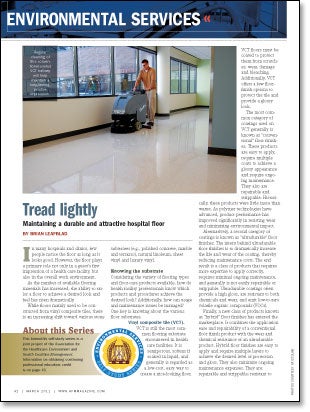Tread lightly
 In many hospitals and clinics, few people notice the floor as long as it looks good. However, the floor plays a primary role not only in a guest's first impression of a health care facility, but also in the overall work environment.
In many hospitals and clinics, few people notice the floor as long as it looks good. However, the floor plays a primary role not only in a guest's first impression of a health care facility, but also in the overall work environment.
As the number of available flooring materials has increased, the ability to tailor a floor to achieve a desired look and feel has risen dramatically.
While floors mainly used to be constructed from vinyl composite tiles, there is an increasing shift toward various stone substrates (e.g., polished concrete, marble and terrazzo), natural linoleum, sheet vinyl and luxury vinyl.
Knowing the substrate
Considering the variety of flooring types and floor-care products available, how do health facility professionals know which products and procedures achieve the desired look? Additionally, how can usage and maintenance issues be managed? One key is knowing about the various floor substrates.
Vinyl composite tile (VCT). VCT is still the most common flooring substrate encountered in health care facilities. It is semiporous, softens if soaked in liquid, and generally is regarded as a low-cost, easy way to create a nice-looking floor. VCT floors must be coated to protect them from scratches, wear, damage and bleaching. Additionally, VCT offers a few floor-finish options to protect the tile and provide a glossy look.
The most common category of coatings used on VCT generally is known as "conventional" floor finishes. These products are easy to apply, require multiple coats to achieve a glossy appearance and require ongoing maintenance. They also are repairable and strippable. Historically, these products were little more than waxes. As polymer technologies have advanced, product performance has improved significantly in resisting wear and minimizing environmental impact.
Alternatively, a second category of coatings is known as "ultradurable" floor finishes. The intent behind ultradurable floor finishes is to dramatically increase the life and wear of the coating, thereby reducing maintenance costs. The end result is a class of products that requires more expertise to apply correctly, requires minimal ongoing maintenance, and generally is not easily repairable or strippable. Ultradurable coatings often provide a high gloss, are resistant to both chemicals and wear, and emit low-to-zero volatile organic compounds (VOCs).
Finally, a new class of products known as "hybrid" floor finishes has entered the marketplace. It combines the application ease and repairability of a conventional floor finish product with the wear and chemical resistance of an ultradurable product. Hybrid floor finishes are easy to apply and require multiple layers to achieve the desired level of protection and gloss. They also minimize ongoing maintenance expenses. They are: repairable and strippable; resistant to scratches, wear, stains and chemicals; and emit low-to-zero VOCs with no odor during application and drying.
Once the finish is applied and the focus shifts to ongoing maintenance, facility professionals may encounter several common problems.
First is the occurrence of white spots in areas where drops of alcohol-based hand sanitizer fall onto a conventional coating and damage it. If a facility uses conventional coatings, immediate and frequent cleaning of spills and drips in the areas under and around alcohol-based product dispensers will help to minimize the damage. However, once white spots appear, the damage will require removal of the coating followed by reapplication. The chemical properties of ultradurable and hybrid finishes make them a viable option in these areas because they are resistant to white spots from sanitizers.
Another common problem is sticky floors resulting from frequent use of quaternary ammonium-based disinfectants for floor cleaning. If a disinfectant is incompatible with a floor finish or if it is not used at the correct concentration, the "quats" in the product may soften or attach to the surface of the floor finish, making it tacky and attracting dirt. The problem can be solved by a periodic rinse and cleaning with a mildly acidic solution (e.g., a neutralizing rinse normally used after stripping a floor).
Sheet and luxury vinyl. Sheet and luxury vinyl are becoming more common as flooring options. Sheet and luxury vinyl are similar to VCT, but they come in larger sheets and offer more printed patterns.
Because the composition of sheet and luxury vinyl is similar to VCT, the product options, usage and maintenance issues are essentially the same. However, when caring for a luxury vinyl floor, which is constructed from multiple layers, facility professionals must avoid damaging the floor by scratching through the surface layer.
Another issue with luxury vinyl is the impact of the material's texture. In particular, when the floor is intended to look like wood, the vinyl can have ridges and valleys. This can cause the finish to pool in the depressions, leaving the raised areas dry and giving a striped appearance to the gloss. In such cases, adding coats of finish may help even out the gloss. Stripping the finish out of the valleys of simulated wood flooring also can pose a challenge. To make the job easier, consider using a stripping brush rather than a stripping pad.
Terrazzo. Another type of flooring that is becoming more common in health care is terrazzo. Like VCT, terrazzo can be coated with floor finish. However, coating terrazzo presents some unique challenges because many floor finishes will not adhere to both terrazzo's marble chips and its matrix material, resulting in an uneven or orange-peel look to the floor.
Because terrazzo is often porous, it may require more coats of finish than a VCT floor to achieve a similar gloss. One option is to use one or more layers of a sealer coat specifically designed for such stone substrates as terrazzo. It will seal the terrazzo and create a surface to which the finish can adhere. Sealers by themselves will not provide the gloss or scratch and wear resistance of a finish and, therefore, should always be given a topcoat of floor finish. Facility professionals should check with the supplier to ensure that the sealer and finish are compatible.
If a slightly lower gloss level is acceptable, some suppliers can provide products that are a combination of a sealer and a finish. More recently, suppliers have been developing hybrid coatings that can be used directly on terrazzo without a sealer. Regardless of which product is used, facility professionals should know whether the manufacturer recommends it for use on terrazzo.
As an alternative to finishing, terrazzo floors also can be polished. Polishing a terrazzo floor will involve multiple steps of grinding with finer and finer abrasive-embedded disks or abrasive compounds. Depending on the floor's condition, the initial polishing process can be labor intensive and somewhat messy due to the polishing powders and creams that typically are used, but the result is a very smooth and shiny floor.
Once the floor is polished, it will be hard and scratch resistant. Ongoing maintenance only requires treating the floor regularly with a cleaner or conditioner to protect the stone. Over time, wear will occur and eventually dull the look of the floor. When this happens, a simpler and more abbreviated polishing process can restore the shine.
Because polished terrazzo is not protected by a floor finish, it can be damaged by acidic cleaners or spills of an acidic beverage that are not promptly cleaned. This damage often shows up as a whitish or hazy spot. However, these spots can be repaired easily with spot polishing.
Linoleum. Natural linoleum flooring has been common in Europe for several years and is increasingly popular in the United States. Natural linoleum requires uniquely different maintenance procedures than sheet and luxury vinyl because natural linoleum has a completely different composition, giving it a softer, less-plastic look. This composition difference also makes it very pH sensitive.
While coating products that can be used on linoleum are generally the same as those used on VCT, the biggest issue is removing the finish. Floor strippers used on VCT or terrazzo typically have a pH of 11-13, which will ruin and discolor a linoleum floor. In fact, it only takes a few minutes of exposure to a pH 13 solution to severely discolor a linoleum floor.
It is therefore important for facility professionals to understand the removal method required for any finish that is being considered for linoleum, and to ensure that it can be done at a pH of 9.5 or lower without significant abrasion. In fact, it is recommended to use only coating, cleaning and stripping products that manufacturers label as linoleum-safe.
Proper procedures
A thoughtful flooring choice in a new facility, based on the maintenance required to keep a desired look, will enable facility professionals to avoid potential problems down the road.
But, if a floor already has been installed, facility professionals need to research the type of flooring and products in use. From there, they can develop appropriate maintenance procedures.
In either case, the proper floor maintenance procedures will allow facility professionals to improve the first impressions and lasting responses of those who enter the facility.
Brian Leafblad is the research and development program leader for Ecolab, Eagan, Minn. He can be reached at brian.leafblad@ecolab.com.
 About this Series
About this Series
This bimonthly self-study series is a joint project of the Association for the Healthcare Environment and Health Facilities Management. Click here for information on obtaining continuing professional education credit.


